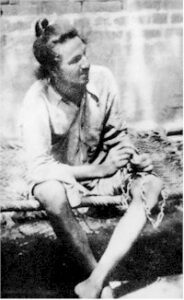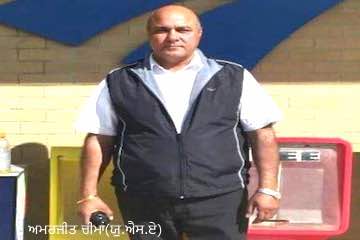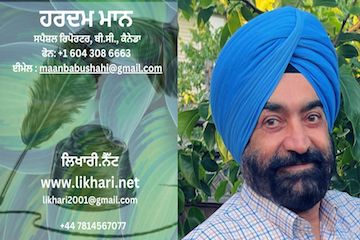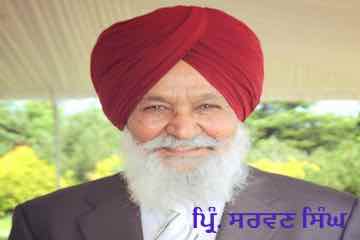|
“The author, Mohinder Bhatnagar, a Masters in English literature, has been writing fiction and other prose since the age of 20. His writings have appeared in prestigious newspapers and magazines in India and abroad. Having been in different professions like a taxman, banker, lawyer, technical editor et al, he has seen life in its varied hues. Widely travelled in USA, Canada and UK he is currently based in New Delhi and is working as a freelance writer, editor and translator. His email id: mkbhatnagar2000@yahoo.co.in and contact number : +91-9818377608.” —-Likhari SHAHEED BHAGAT SINGH: Little known facts by Mohinder Bhatnagar
Kartar Singh Sarabha, hanged at the age of 19 by the British in the first Lahore Conspiracy case was Bhagat Singh’s hero. Bhagat Singh always carried Sarabha’s photo in his pocket. Ironically, Bhagat Singh met his death in the Second Lahore Conspiracy case. He became “Shaheed Bhagat Singh” or Martyr at the age of 23 and 6 months. Bhagat Singh never returned home after attending a meeting of revolutionaries in Delhi in 1928. Though always focused on his mission, Bhagat Singh was not a dour or boring person. He was on the contrary quite jovial and loved cracking jokes with his friends. A great movie buff, his special favourites were Charlie Chaplin films, which he watched even at the expense of going hungry. Thanks to many of his friends who were Bengalis, like B.K. Dutt, Bhagat Singh also developed a taste for ‘rasgullas’. In two or three letters to his friends, he asked them to arrange ‘rasgullas’ for him whenever and from wherever they could. A fairly good journalist, Bhagat Singh edited the Urdu paper Kirti from Amritsar. He also edited Akali (Amritsar). He sometimes contributed to the Arjun (Delhi) and Pratap (Kanpur) under the pseudonym of ‘Balwant Singh’. At the Lahore Central Jail where he spent his final days, the books he asked for and read included ‘Militarism’, ‘Why Men Fight?’ ‘Society at Work’, ‘Collapse of Second International’, ‘Civil War in France’, ‘Land Revolution in Russia’ and ‘Peasant in Prosperity and Debt’. He was reading a book on Lenin when he was called to be hanged. The two bombs thrown in the Assembly Hall by Bhagat Singh and B.K. Dutt were weak ones and they neither killed nor injured anyone. This was done intentionally only as a token protest. After the incident, the government seized material that could be used to make seven thousand bombs. The hanging was fixed for March 24, 1931. Fearing the popular backlash, Bhagat Singh, Sukhdev and Rajguru were executed on March 23 itself. The preparations to execute the trio took place furtively. Even the members of their families were not allowed to meet them. All the three were cheerful even on the day of hanging. They competed with one another to be hanged first. It was decided that Sukhdev would be hanged first, then Bhagat Singh and finally Rajguru. All the three climbed the platform eagerly, kissed the noose and themselves put it round their neck. They died with the name of Bharat Mata on their lips. The half burnt ashes of Bhagat Singh, Rajguru and Sukhdev including the blood soaked sand and blood stained newspaper (The Tribune) in which their ashes were wrapped are preserved and exhibited in the museum at Bhagat Singh’s native village Khatkar Kalan near Jalandhar. Upon entering the Jalianwala Bagh, General Dyer immediately ordered troops to fire directly upon the assembled gathering. Firing continued unabated for about 10 minutes till his troops’ ammunition of 1650 rounds was fully exhausted, leaving over 1800 dead as per a report. Barely 12 years, Bhagat Singh visited Jalianwala Bagh soon after the carnage and took a pledge to redeem his motherland’s honour by avenging the massacre. General Dyer, later dubbed as The Butcher of Amritsar, could not enjoy a comfortable sleep even for a day after the massacre. Stricken with paralysis in 1921, he never recovered and died at Long Ashton, near Bristol, on July 23, 1927 of Atherosclerosis and cerebral hemorrhage. |


 by
by  Born on September 28, 1907, Bhagat Singh was called ‘Bhaganwala’ (the fortunate one) at his birth. His family believed that he had brought with him good luck as his uncle Ajit Singh was released from Mandalay jail the same day. Bhagat was a lovely child; his smile was charming. He was highly interested in studies and was ahead of the others. Very much liked by his classmates, big boys used to carry him on their shoulders to the school and back home. While in the fourth class, Bhagat Singh asked his classmates: “What do you wish to become when you grow up?” Each boy gave a different answer. When they asked Bhagat Singh the same question, he replied, “I will drive the British out of India.”
Born on September 28, 1907, Bhagat Singh was called ‘Bhaganwala’ (the fortunate one) at his birth. His family believed that he had brought with him good luck as his uncle Ajit Singh was released from Mandalay jail the same day. Bhagat was a lovely child; his smile was charming. He was highly interested in studies and was ahead of the others. Very much liked by his classmates, big boys used to carry him on their shoulders to the school and back home. While in the fourth class, Bhagat Singh asked his classmates: “What do you wish to become when you grow up?” Each boy gave a different answer. When they asked Bhagat Singh the same question, he replied, “I will drive the British out of India.”





